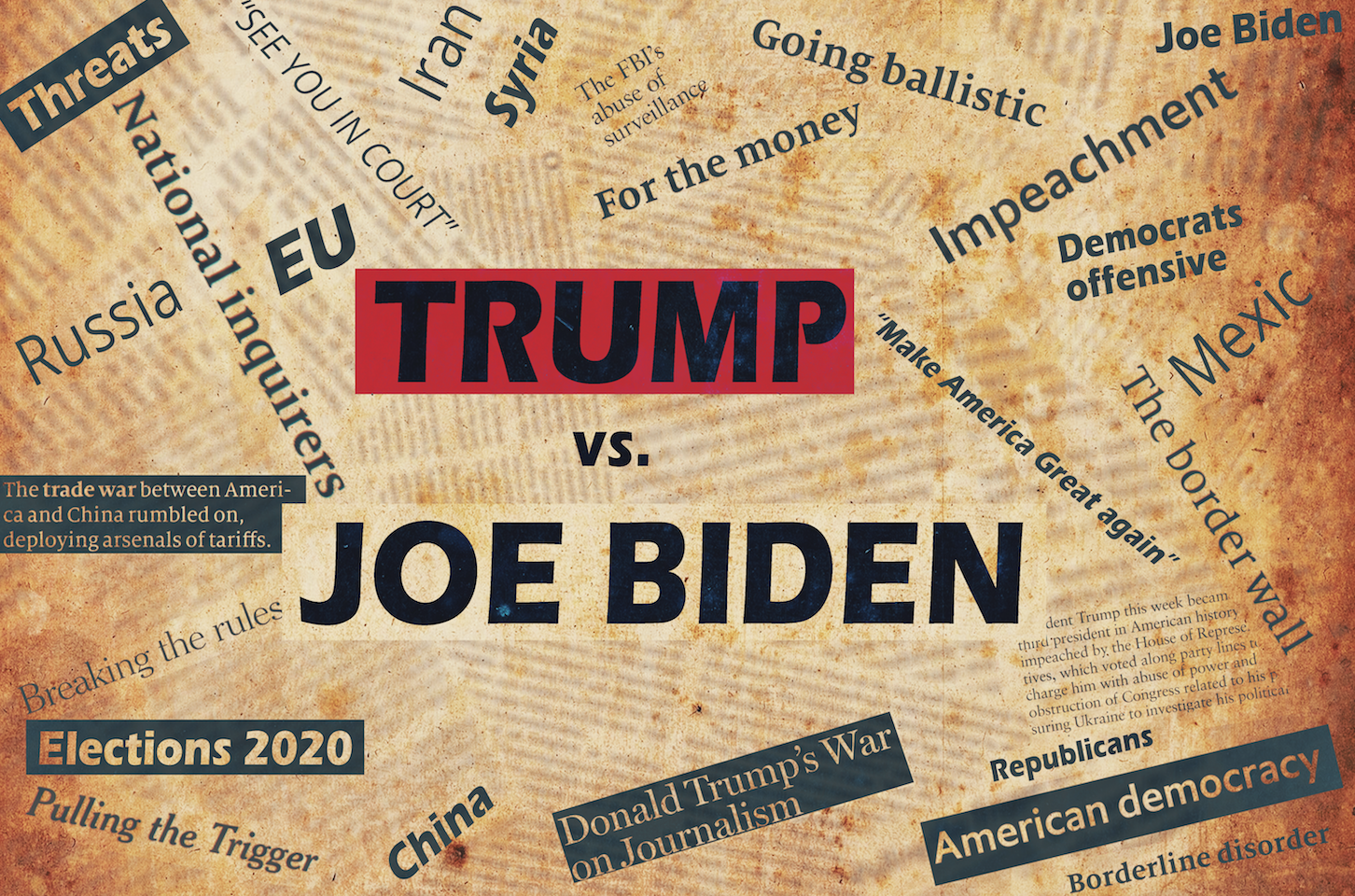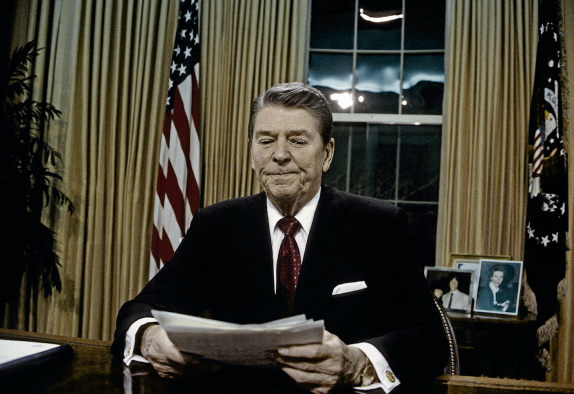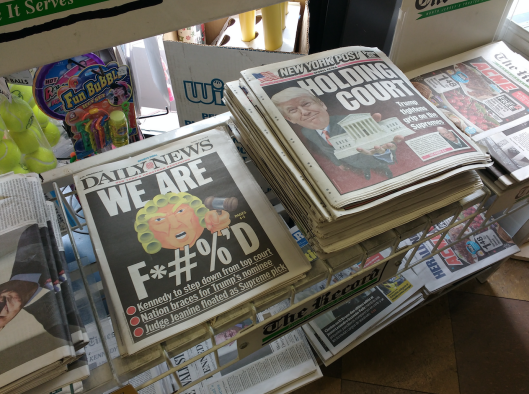
If presidential elections were won on newspaper endorsements, Joe Biden would be on course for the most resounding victory in US voting history.
But Democrats should not pop open the Champagne too quickly because if media endorsements were votes, Hillary Clinton would likely be fighting re-election four years after trouncing Donald Trump.
Despite winning the backing of the New York Post earlier this week, Trump has – for the second election running – suffered a heavy defeat to his Democrat rival in terms of newspaper endorsements, with every other major title endorsement going to Biden.
But, following Trump’s victory over Clinton in 2016, Press Gazette today analyses whether newspaper endorsements matter in 2020.
With the formal election date just days away, we use historical data to examine how common it is for America’s largest newspapers to favour one candidate so heavily.
We also look at the correlation, or lack thereof, between newspaper endorsements and the public vote.
And we explore the debate over whether newspapers should make endorsements – and whether, in 2020, they make any difference in elections.
How Republicans lost newspaper support over 40 years
“For us, as for millions of voters, it is a close call and a difficult one,” said a New York Daily News editorial in October 1980. “But with many misgivings, and more hope than certitude, we recommend the election of Ronald Reagan.”
For Republican candidate Reagan – who would go on to beat incumbent Democrat Jimmy Carter days later – this was arguably one of the most significant endorsements of his campaign.
With a circulation of more than 1.5m, the Daily News was at that time America’s second-largest newspaper, behind the Wall Street Journal, which has a non-endorsement policy.
That year, seven out of the 20 largest newspapers in America backed the Republican candidate, according to research by the St Louis Journalism Review.
As our graph (above) shows, the overwhelming editorial support Biden and Clinton have enjoyed in the past two election campaigns from America’s largest 20 newspapers* is unprecedented in recent political history.
Through the 1980s, 1990s and early 2000s, support for Democratic and Republican candidates ahead of elections was divided almost equally between the nation’s largest newspapers.

President Ronald Reagan (credit: Mark Reinstein/ Shutterstock)
The popularity of Barack Obama in 2008 shook up the dynamic, with just three top-20 newspapers backing his Republican rival, John McCain. That year, the Chicago Tribune endorsed a Democrat for the first time in its 161-year history, while the Houston Chronicle also broke with its right-leaning tradition.
In 2012, Obama lost the support of several newspapers that had previously backed him – including the Houston Chronicle, New York Daily News and Newsday – to Mitt Romney.
However, the emergence of Donald Trump as the Republicans’ 2016 candidate made history by dissolving all support for the party among the nation’s largest newspapers.
The Arizona Republic – which said Trump “is not conservative and is not qualified” – backed a Democrat, Clinton, for the first time in its history. Likewise, the Dallas Morning News endorsed Clinton, marking the first time it had backed a Democrat since World War II.
The right-leaning New York Post declined to back any candidate.
And USA Today, founded in 1982, broke with its non-partisan traditions by advising its readers not to vote for Trump.
2020 endorsements

Photo credit: Erin Alexis Randolph/ Shutterstock
This time around, USA Today has gone a step further with an outright endorsement for Biden, who – its editorial board declared – “offers a shaken nation a harbour of calm and competence”.
Biden has also won over the Chicago Tribune, which endorsed Libertarian Gary Johnson in 2016.
However, he has lost the support of the Arizona Republic and the Dallas Morning News, both of which made waves by supporting Clinton in 2016 but have decided against making endorsements in 2020.
The New York Times, Los Angeles Times, Washington Post, Boston Globe all endorsed Biden over Trump.
At the time of writing, the American Presidency Project – whose circulation ranking figures differ slightly from Press Gazette’s – had recorded that five noteworthy newspapers have backed Trump ahead of next week’s vote, compared with Biden’s 44.
The five are the New York Post – which said it was doing so to recognise his “actions and accomplishments” rather than his “tweets and extemporaneous remarks” – the Las Vegas Review-Journal, Little Rock’s Arkansas Democrat-Gazette, the Spokesman Review and the Gazette (Colorado Springs).
The relationship between endorsements and votes
In its endorsement of Biden, the editorial board of USA Today acknowledged that most voters – as many as 90%, according to one poll – will already have decided who to vote for in this election.
The result of the 2016 election struck a blow against the argument that newspaper endorsements have any kind of major impact on voting decisions – and even against the view that newspaper editorials reflect, rather than affect, the general views of the population.
Hillary Clinton did win the popular vote – but it would have to have been a landslide to reflect the views of editorial boards across the country.
The graph above compares top 20 newspaper** support for Republican versus Democrat candidates (discounting non-endorsements and endorsements for candidates from other parties) with electoral support (counting only votes that went to Republicans and Democrats, discounting votes that went to other parties).
This shows that, when it comes to presidential elections, the editorial boards of America’s newspapers have been left-wing of the voting public since 1992 when Bill Clinton was presidential nominee for the Democrats.
From 1980 to 2016, the votes between Republicans and Democrats have been split roughly down the middle, with neither party claiming more than 60% of their combined vote.
The four graphs below show how newspaper support for Republican candidates fell gradually in recent decades – from 54% to 0% – while the party has continued to claim about around 50% of votes that have gone to the two main parties.
‘Rather than unsigned editorials, our readers wanted more perspective’
Arguably, the two most dramatic presidential endorsements over the past 40 years came in 2016 when the Arizona Republic and Dallas Morning News ditched their Republican roots to back Clinton over Trump.
This year, however, both newspapers rowed back and announced they would not back any candidate in 2020.
The Arizona Republic explained in an editorial that, following reader research, it has decided it will never again make presidential endorsements.
“Centuries-old conventions such as editorials and candidate endorsements are less important to readers today than when our words appeared only on newsprint,” wrote executive editor Greg Burton and editorial page editor Phil Boas.
“Rather than unsigned editorials, our readers wanted more perspective from informed observers identified by names and credentials.
“They don’t want their daily newspaper or news website telling them which candidates and which party should get their votes.
“To be clear, we never viewed our endorsements that way. We often told readers this was only our opinion, one source among many that should inform their votes. But more and more of today’s readers see candidate endorsements as an intrusion on the electoral process.
“They tell us our endorsements alienate them and blur the way they read our news stories. They don’t see the sharp line we draw between our news and opinion content.”
The Arizona Republic and Dallas Morning News are not alone. The Wall Street Journal, America’s biggest newspaper, has not endorsed a candidate since 1928.
CNN editor-at-large Chris Cillizza agrees that there is no place for newspaper endorsements in 2020.
In the US press, endorsements are made by editorial boards, which are strictly independent of news teams. But Cillizza recently argued in an op-ed for CNN that most of the American public will not appreciate this, to the detriment of the newspapers.
“In a world in which the President of the United States has shown he is more than willing to make things up, spread manipulated video and do all sorts of other things to sully the media and its reputation, the idea that people would distinguish between the editorial board of a media organisation and its reporters is farcical,” he said.
“Not only do editorial board endorsements confuse people, it also makes it harder for great reporters who work at these institutions to do their jobs. Because people point to the editorial board endorsement of Biden and say, ‘Well, we know who your paper wants to win!'”
‘I don’t think that we go into this thinking that we’re power-brokers’
Despite these concerns, the majority of America’s large newspapers have endorsed a candidate in 2020, and will likely continue to do so for years to come.
The Los Angeles Times is a newspaper that had a long-standing policy, from 1972, of not endorsing candidates. But it broke with this tradition in 2008 to back Barack Obama and has continued to endorse candidates since.
Michael McGough, a senior editorial writer at the Los Angeles Times who was part of the editorial board when it decided to back Obama, explained that he and colleagues saw its 2008 endorsement as a “return to normalcy”.
“I think we all felt that telling readers what we think about presidential candidates is part and parcel of what we do every day,” he told Press Gazette. “Which is to do our best to explain our opinions on all sorts of public policy questions. And what is a more important public policy question than who will be the next president of the United States?”
McGough also sought to challenge the view that newspaper editorials are designed solely to tell readers how to vote.
“I know there are some newspaper proprietors who see political endorsements as a sort of exercise of power,” he said. “I think we see them, at least I do, more as an exercise in public education. Obviously, we hope that our arguments are persuasive and will leave voters to choose the candidates we’ve endorsed. But I don’t think that we go into this thinking that we’re power-brokers.”
He added: “We hope to be influential, of course. We hope that our arguments persuade readers. But, as I said before, I think it’s as much a civic education project as an attempt to wield power.”
Asked about concerns that endorsements may undermine the public’s trust in reporters to work without favour – because of a potential lack of knowledge about the division between news and opinion departments – McGough said: “I do think there’s probably no way to dispel that suspicion in the minds of some readers.
“I think we do a good job – day in, day out, not just during elections – of explaining the distinction between the news side, which reports the news, and the editorial board, which expresses opinion.”
He added that there should be enough explanatory resources online for readers to be able to understand how editorial boards work and how they operate separately from news teams.
“I think all of this conduces to people, who are willing, to make the distinction and understand the difference,” he said.
“Some people, obviously including politicians, can have a vested interest in not understanding the difference. If you’re a politician who doesn’t like news stories written about you, there’s a real temptation to say: ‘Well, of course, you’re being unfair to me – the editorial page of this very newspaper endorsed my opponent.’ You’re always going to have that.
“But I think we do a good job of explaining to people that there is this difference.”
*The largest newspaper list reflects the newspapers that have most frequently appeared in the top 20 circulations in presidential years between 1980 and 2020, based on figures from the St Louis Journalism Review, American Presidency Project and the Alliance for Audited Media. It does not reflect the top 20 as of this year. It is difficult to define the top 20 list as of this year because not all newspapers submit their circulations for audit. Arguably, print circulation figures would also, in 2020, be irrelevant because most readership is now online.
**In the second instance, the top 20 newspapers (unnamed in the chart) are correct as of the election years, as reported by the St Louis Journalism Review and American Presidency Project.
Cover photo credit: Shutterstock/ Creative Lab
Email pged@pressgazette.co.uk to point out mistakes, provide story tips or send in a letter for publication on our "Letters Page" blog






